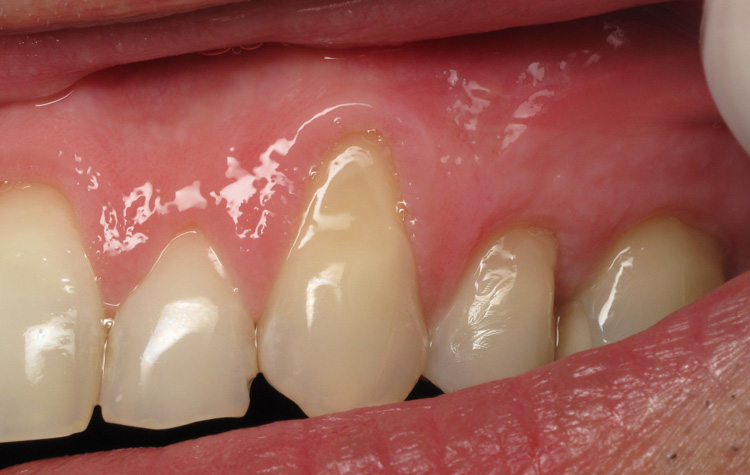Gum recession
Gum recession is shifting of gums edge (gingiva) to the root of the tooth. Gum recession can affect all or almost all of teeth (generalized gum recession), and can even affect only on certain teeth. Gum recession from the teeth can be different sizes and shapes.

The initial stage of periodontal disease is an inflammation of gums (gums bleed, they are red and enlarged), After this stage comes to the deterioration of the gums and denudation of the root causing the teeth appear elongated. This is a very advanced stage of periodontal disease and it comes with the gums withdrawal of all or most of the tooth. The withdrawal of the gums does not mean only the loss of soft tissue, it also mean the loss of bone tissue. Over time, the bone tissue is so damaged that comes to bobbing and loss of teeth that are clinically healthy. This is terminal stage of periodontal disease. Accordingly, the withdrawal of the gingiva that is generalized occurs not only from the outside (vestibular side) of the teeth, but the whole soft tissue around the tooth. Scale is caused by the deposition of minerals in soft plaque (dental plaque). This is the basic cause of the gum recession and bone loss, which “escapes” from these irritations.
Gum recession that is not manifested on all teeth, but only on one or a few, usually characterized by exposing the teeth roots from the outside.
 One of the causes of gum recession can be occlusal trauma. Occlusal trauma occurs when closing the jaw, some teeth come into contact with food (or anything else) before the rest of the teeth and that leads to their overloading (trauma). When it comes to the destruction of the gums and bone tissue. There are two causes of early contact of teeth. The first is the loss of teeth, when tilt of the remaining teeth in the jaw and they shifts and then come up with an irregular load of these teeth. Also, the problem is “floating of” the tooth from the opposite jaw to the newly formed space. Another reason is the anomaly of teeth. Due to the irregular arrangement of teeth in the jaw leads to unbalanced load. This case usually leads to gum recession, or bone loss on one side. In this case, it may lead to difficulty in cleaning the oral cavity due to the inaccessibility of certain parts of the jaw which can be very bad. Poor brushing technique can also cause gum recession. Aggressive tooth brushing (higher pressure than is necessary, too hard brushes, tooth brushing with horizontal movements) should be avoided. Because this method of brushing teeth may result in withdrawal of gums from the teeth. Also, inadequate prosthetics and fillings can cause gum recession. So do not allow to anyone to take care of the health of your teeth.
One of the causes of gum recession can be occlusal trauma. Occlusal trauma occurs when closing the jaw, some teeth come into contact with food (or anything else) before the rest of the teeth and that leads to their overloading (trauma). When it comes to the destruction of the gums and bone tissue. There are two causes of early contact of teeth. The first is the loss of teeth, when tilt of the remaining teeth in the jaw and they shifts and then come up with an irregular load of these teeth. Also, the problem is “floating of” the tooth from the opposite jaw to the newly formed space. Another reason is the anomaly of teeth. Due to the irregular arrangement of teeth in the jaw leads to unbalanced load. This case usually leads to gum recession, or bone loss on one side. In this case, it may lead to difficulty in cleaning the oral cavity due to the inaccessibility of certain parts of the jaw which can be very bad. Poor brushing technique can also cause gum recession. Aggressive tooth brushing (higher pressure than is necessary, too hard brushes, tooth brushing with horizontal movements) should be avoided. Because this method of brushing teeth may result in withdrawal of gums from the teeth. Also, inadequate prosthetics and fillings can cause gum recession. So do not allow to anyone to take care of the health of your teeth.
Treatment of gum recession
How to treat gum recession? Universal cure for gum recession does not exist. causes of gum recession should be removed so gums could recover. Depending on the cause, should be done:
- Surgical corrections to gums;
- Remove traumatic contact with selective grinding of the teeth;
- Correct the irregular position of teeth, orthodent therapy;
- Replace poorly placed prosthetic;
- Surgical repair highly placed frenulum and blister;
- Maintain proper oral hygiene;
- Prosthetic rehabilitation.